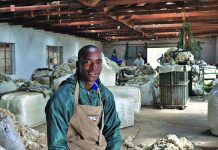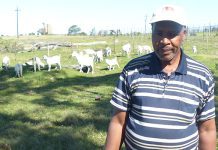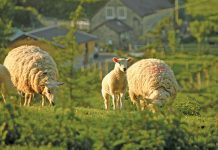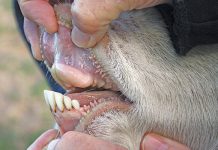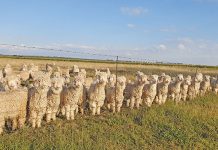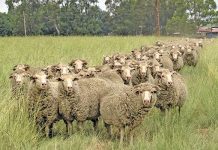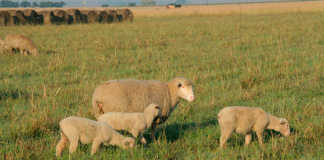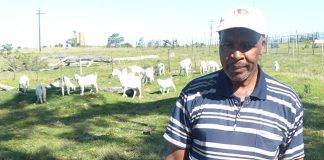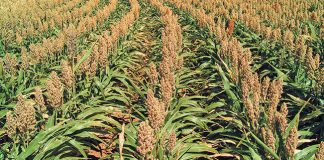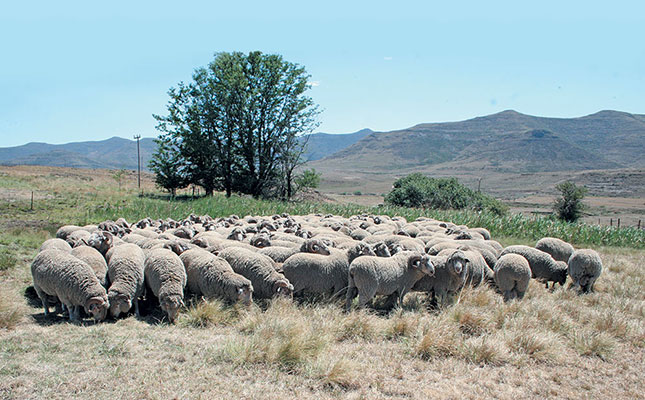
Tink Strydom of Hartebeesfontein started farming with his father Sarel in 1992. When Sarel passed away in 2007, Tink took over the business, which, at the time, comprised three farms: Hartebeesfontein (205ha), Clifford (800ha) and Elandsdraai (195ha).
“My aim is to achieve the maximum possible income per hectare with my Merinos with the least possible damage to the veld,” he says. “I also try to breed sheep that have good breadth and depth of body. I firmly believe that the most important part of a sheep is its stomach, as this is where food is kept for growth. A sheep with a small stomach never gets big.”
The Hartebeesfontein Stud Merino ewes must shear at least 5,3kg to 5,8kg of good quality white wool a year. This type of ewe is normally more productive and fertile. The average greasy wool weight of the total flock is between 5kg and 5,3kg.
Tink has virtually stopped using rams from other breeders in order to increase consistency and improve the strike rate and prepotency of his Merino flock. “I’m striving to stick to a certain type of Merino in my stud to making my sheep unique,” he explains.

Tink Strydom with his staff. From left: Mzunzima Bossiekop May, Patrick Glopekile May, Zonisele Stefen Holanie, Zakade Jannewarie May, and Zuzekile Patrick Foci.
He makes an occasional exception for an outstanding ram that he comes across, but first tests it on his flock through AI before using it cautiously on his stud.
Tink has rented an extra 1 200ha since 2008. All the farms are located in the Eastern Cape’s mountainous Barkly East district. The height above sea level ranges from 1 720m to 2 200m; winters are very cold, and summers are cool to moderate.
The area receives an average of 600mm of rain a year, mostly in summer, from September to March. The past year has been very dry, however.
Most of the grazing is mixed grassland. The south-facing slopes are covered with unpalatable grass, such as wiregrass (Elionurus muticus), Tenaxia disticha (sometimes called mountain wiregrass) and patches of turpentine grass (Cymbopogon spp).
“The northern slopes have more palatable grasses,” says Tink. These include rooigras (Themeda triandra), Setaria species such as small creeping foxtail and Eragrostis species such as weeping lovegrass.
“Some of the land bought more recently was heavily overstocked by the previous owners and we’re still working at improving the condition of the veld by giving it ample resting time in summer.”
He relies on the dryland lucerne lands for summer grazing to help alleviate the pressure of overgrazing his veld at this critical time. Average grazing capacity is one sheep/ha, that is, 1SSU/ha or 1LSU/6ha.
The soil consists mostly of basaltic black clay loam. Arable land on all the farms combined amounts to 450ha, of which 55ha is under irrigation. “I used to believe in planting wheat and rye for green feed on drylands,” recalls Tink.
“It was a practice I ‘inherited’ from my father and grandfather. But I’ve realised the value of lucerne and have about 100ha dryland lucerne. “I plant my old lucerne lands to wheat and rye as an alternate crop before replanting them to lucerne again.”
A centre-pivot irrigates 32ha planted to sweet sorghum and lucerne, which will be cut and baled for silage and feed.
Mating
When Tink started farming, he and his father lambed only 650 ewes. His grandfather, also named Tink, started the stud in 1938 and registered it in 1954.
“The stud and flock are run together and not separately as with most studs. This helps me to select the correct type of ewe for the farm,” he explains. The Hartebeesfontein Stud produces a type of Merino that does well on grassveld, has good conformation and produces good medium to strong wool.
“Every year, I select two young two-tooth rams. These are then mated to 80 ewes using the laparoscopic artificial insemination (AI) technique. The ram that breeds the best is then used the following year on 800 ewes.”
The mating of the stud ewes is done during the first two weeks in March, when 1 200 ewes are mated by AI. Tink prefers the laparoscopic procedure developed in Australia, which has higher success rates than other methods.
Five days after mating, Tink selects the 50 best seven-month-old ram lambs and bunch mates them to the 1 200 ewes for 21 days. Selection of the young rams is based on body and testes size, as well as wool quality.
“During the middle of March, I use natural mating for the remainder of the flock at a ratio of one ram to 40 ewes for 21 days,” explains Tink.
He uses trickle feeding to get the ewes into top condition. Only in bad years does he dose them with Ovimin, a drench high in minerals.
Lambing
“About eight weeks after mating, during May, the ewes are scanned for pregnancy confirmation. Those carrying twins and triplets are marked accordingly and separated,” says Tink.
Most years, the stud has a conception rate of 93% to 98% with 40% to 65% of the ewes bearing twins and triplets.
Normally the lambs are weaned at 105 to 110 days of age. But this is strongly influenced by prevailing conditions; this year, the lambs were weaned at 45 to 66 days.
Tink was one of the first farmers in the Clifford area of Barkly East to use lambing pens. He believes they have proved their worth, as he has seen an increase in lamb numbers. The pens are used only for ewes carrying more than one lamb.
Ewes carrying single lambs are placed in small camps with good shelter. “This is especially important, given the cold winds here,” says Tink.
Every morning, the ewes that have lambed are taken to a land of green feed or a lucerne pasture. The ewes carrying twins and triplets are put into the lambing pens one day before they are due to lamb with a complete feed ration.
Those who produce twins are left in the pens for 24 hours with their lambs before being moved to a land of green feed or a lucerne pasture. Ewes with triplets are left for up to three or four days before being moved. They also receive an energy supplement to increase their milk production.
All young ewes that are below standard for the stud and flock, and all surplus ewes are sold at an annual production sale.
Breeding ewes are normally allowed to lamb only three times before being sold at the sale. Exceptionally good breeding stud ewes are allowed to lamb five times before being sold.
Ewes that do not conceive within 21 days are also sold. “I don’t keep old ewes on the farm,” says Tink.
Dosing
The ewes are dosed after lambing. During wet years, they are also dosed before mating, especially for wireworm and nasal worm. Lambs are dosed three times before weaning and once after weaning for wireworm.
All the sheep are shorn once a year, but Tink is keen to move to a six-monthly shearing period. He currently shears at the end of September, when the weather is normally not too cold. His wool averages between 19 and 21 microns. This gives him the best weight-to-price ratio with an average of 68% to 72% clean fleece yield.
The sheep are dipped straight after shearing with a spray dip to prevent ticks and red lice.
Breeding values
Tink uses Best Linear Unbiased Prediction (BLUP) to monitor value traits and obtain the breeding values of rams used in the stud.
“It’s a very good guide of future progeny,” he says.All young ewes and rams are Prestige-tested and have BLUP figures assigned at the age of 14 and 10 months respectively. Rams are sold annually at two production sales. One is held in January on Hartebeesfontein and the other in March in Frankfort.
The age of the production sale rams is 18 to 20 months, when they have two teeth. “A very strict selection process is used,” stresses Tink. Only 18% to 20% of the rams – about one in five in a flock of more 700 – are selected for the production sales.
Phone Tink Strydom on 045 971 9097, or email him at [email protected].

